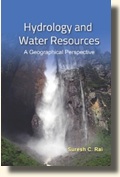
|
Hydrology and Water Resources - A Geographical Perspective by Suresh C. Rai |
|
|
Cover Price : Rs 1,195.00
|
Imprint : Ane Books Pvt. Ltd.
ISBN : 9789385462818
YOP : 2017
|
Binding : Hardbound
Size : 6.14” X 9.21”
Total Pages : 230
CD : No
|
|
About the Book :-
Geographical Perspective of Hydrology and Water Resource describes the physical and human aspects affecting the water resources. This book is a comprehensive analysis of the important aspects of the hydrology and water resources. This book as a humble offering to the service of all those interested in water resource management. The book is the ideal test for post
graduate and research scholars of Indian and Abroad Universities students. This book is designed in such a manner that it covers all aspects of hydrology and water resources. The data used in this book is based on mostly Indian case study.
Contents:-
INTRODUCTION, Part-1: Hydrologic Cycle and Water Balance 1. Hydrologic Cycle 2. Water Balance Part-2: River Basin and Problem of Regional Hydrology 3. River Basins 4. Floods 5. Drought Part-3: Groundwater Assessment and Development 6. Groundwater
Part-4: Water Resource Problem 7. Water Demand and Supply 8. Water Pollution 9. Interstate Water Disputes 10. Water Rights and Water Markets 11. Governance and Finance Part-5: Water Resource Management 12. Watershed Management 13. Water Policy,References, Appendix.
About the Author:-
Prof. Suresh C. Rai received his M.Sc. and Ph.D. degree from Banaras Hindu University (BHU), Varanasi and is teaching physical geography, geomorphology and hydrology and water resource management at the Department of Geography, Delhi School of Economics, University of Delhi since 2005. Before joining University of Delhi he worked as Senior Scientist in G.B. Pant Institute of Himalayan Environment and Development (An Autonomous Institute under Ministry of Environment and Forests, Government of India) at its Sikkim and North-East unit. His principal areas of research are Watershed Management, Mountain Hydrology, Ecotourism and Biodiversity Conservation in the mountainous region. He is also associated in various capacity and positions with many Institutions and Organizations such as UGC, ICSSR, NCERT, CBSE etc. He has completed several projects of DST, CSIR, and Ministry of Agriculture, Government of India and USAID. Prof. Rai was recipient of Highly Commended Paper Award-2016 from U.K and Honourable Mention Best Paper Award, 1998, from Soil and Water Conservation Society, USA. He also received Professor Bandaru Hema Malini Eminent Geographer Award, 2013, from National Association of Geographers, India for his contribution in the field of Geography.
Prof. Rai delivered lectures and participated in a number of meetings organized by International Geosphere-Biosphere Programme (IGBP) core projects “Biospheric Aspects of Hydrological Cycle” (BAHC), IUCN, IAHS & IAH and International Human Dimensions Programme (IHDP). He has published several dozen research papers in various peerreviewed journals and chapters in Books.
|
|
 |
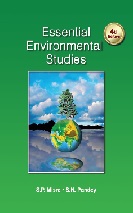
|
Essential Environmental Studies, 4th Edn. - S. P. Misra |
Author |
S. P. Misra
S. N. Pandey
|
|
Cover Price : Rs 2,995.00
|
Imprint : Ane Books Pvt. Ltd.
ISBN : 9789384726638
YOP : 2023
|
Binding : Hardbound
Size : 6.25" X 9.50"
Total Pages : 820
|
|
About the Book :-
Constantly increasing environmental awareness and on readers demand, the book has deservedly earned its fourth edition. While retaining all its basic features, the text has been completely revised and updated assimilating necessary amendments while keeping its originality and presentation pattern intact. Latest information on topics of various Ecosystems, Ecological Pyramids, Biodiversity Conservation, Environmental Pollution, Population Growth etc. has been included. New additions like Global Cooling, El Nino and La Nina, Sunderland (hot spots) will further augment merit of the text. Acute shortage of electricity is adversely affecting development of the Country. The estimated demand for energy will be four times more by 2025. At present, there is no clear and definite vision to fulfil such a massive requirement of electricity in the future. Nuclear energy seems to be perhaps the only alternate that the government is focusing on. This problem has been freshly evaluated in the text. Inclusion of recent data of census (2011), urbanisation and automobile pollution, new boxes and updated special environment calendar will further enhance its utility inducing environmental awareness. Introductory contribution of Shri Kailash Satyarthi, the recent Nobel Laureate for Peace (2014) is appropriately cited.
Contents:-
UNIT I Multidisciplinary Nature of Environmental Studies, UNIT II Natural Resources: Renewable and Non-Renewable Resources, UNIT III Ecosystems, UNIT IV Biodiversity and its Conservation, Unit V Environmental Pollution, UNIT VI Social Issues and the Environment, UNIT VII Human Population and the Environment, UNIT VIII Field Work.
About the Authors:-
Prof. S.P. Misra, formerly Senior Reader, Biopollution Study Centre, Department of Botany, Christ Church College, C.S.J.M. University, Kanpur, has a long experience of teaching Botany and Environmental Sciences. During his active service, he kept himself engaged in research publications and attending National and International Conferences. Credited with co-organising two National Conferences on the Environment, he has attended Millennium Wetland Event-2000, an Intemational Conference, at Canada and presented his paper and undergone a course on Wetland Restoration and Conservation conducted by Ducks Unlimited. He is the author of Taxonomy of Angiosperms, Plant Tissue Culture and Environment and Ecology published by Ane Books Pvt. Ltd., New Delhi.
Dr. S.N. Pandey, formerly Principal, B.R.D. College, formerly Sr. Reader, Botany Deptt., D.A-V. College, C.S.J.M. University, Kanpur, passed M.Sc. (1966) in first division with first position from Agra University and obtained Ph.D. from Kanpur University. He has published over 70 research papers in reputed Indian and foreign research journals, and has supervised several students leading to Ph.D. degree. While he has co-organised 1 international and 3 national conferences, he has also attended several international conferences including International Botanical Congress, Berlin; Millennium Wetland Event, 2000, Quebec; refresher course with Ducks Unlimited, Canada etc. and has visited countries like Germany, Austria, Switzerland, France, Italy, USA, UK, Canada etc. Besides vast and variegated teaching experience both at undergraduate and postgraduate levels of over 40 years, he has to his credit a few well-acclaimed books—Plant Physiology, Textbook of Botany (3 vols.), Taxonomy of Angiosperms, Environment and Ecology. He is the Chief Editor of Research Journal of Plant and Environment.
|
|
 |
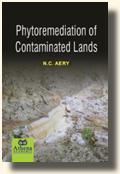
|
Phytoremediation Of Contaminated Lands - N.C. Aery |
|
|
Cover Price : Rs 2,495.00
|
Imprint : Ane Books Pvt. Ltd.
ISBN : 9789389212747
YOP : 2016
|
Binding : Hardbound
Size : 6.25
Total Pages : 506
CD : No
|
|
About the Book
The present book contains the most relevant and up-to-date literature on phytoremediation technology with the aim to develop a basic and state-of-the-art volume on various theoretical and practical aspects in the realm of Phytoremediation. Most of the available books on the subject are edited volumes and present fragmented information. The present volume has the advantage of coherence of the subject matter which has been presented in an organized sequence. This compendium would serve a great purpose for all those students, teachers, scientists and research workers who are willing to deal with different problems of plant-soil relationships. As information on most of the techniques used in phytoremediation would be available at hand this would ease the job of workers in the field. This information would be of much importance to persons such as botanists, foresters, environmentalists, physiologists, nutritionists, agronomists as well as biogeochemists and persons particularly engaged in revegetation programmes.
The book begins by examining the problem, describing different type of wastes, their origin and production and various disposal systems, tailings, tailing dams and the effects of contaminants on biota, waste characteristics and the strategies available for remediation. Various subsets of phytoremediation technology such as Phytoextraction, Phytovoltalization, Phytostabilization, Phytodegradation, Rhizofiltration and Rhizodegradation have been discussed in detail. The text moves on to focus the latest information about elemental accumulation in plants, their uptake and translocation, role of phytochelators and phytosiderophores, the concept of accumulators and hyperaccumulators. Choice of plant species and methods of their establishment, considerations adopted in selection of plant species, the methods used and the most suitable agronomic practices to be adopted have been described. A chapter on conditioning alternatives describing various amendments such as FYM, poultry manure, sewage sludge, domestic refuse, saw dust, biogas slurry, fly ash, biochar, zeolite, bone meal, fertilizers, liming and the use of micro-organisms including Mycorrhizae, PSBs and Rhizobium has also been provided. A chapter deals with ways and means to enhance phytoextraction and its advantages and disadvantages. Attention has also been drawn towards advantages, limitations, prospects and economics of phytoremediation technology. Further, a chapter on biotechnological approaches to phytoremediation has been included. In the last, to trigger interest amongst teachers and students of higher-learning in the domain of phytoremediation, certain case studies which are based on the work carried out in author’s laboratory have been included. These would be illustrative for other such type of work to be carried out in India and abroad.
CONTENTS
Chapter 1. Contaminated lands
Chapter 2. Waste characteristics
Chapter 3. Remediation of the contaminated lands
Chapter 4. Phytoremediation strategies
Chapter 5. Elemental accumulation in plants
Chapter 6. Selection of plant species
Chapter 7. Agronomic practices for phytoremediation
Chapter 8. Conditioning of waste
Chapter 9. Assisted phytoextraction
Chapter 10. Land -use options
Chapter 11. Advantages, limitations, prospects and economics of phytoremediation
Chapter 12. Biotechnological approaches to phytoremediation
Chapter 13. Case studies
Literature cited
Appendices i - iii
About the Author
Prof.N.C.Aery is Professor of Botany and formerly the Head, Dept. of Botany & Associate Dean, University College of science, Mohanlal Sukhadia University, Udaipur, Rajasthan, India. For the last 33 years or so, he is engaged in teaching environmental sciences and taxonomy of higher plants to the postgraduate and undergraduate students. His research interest included different areas in plant Sciences namely, Geobotany and Biogeochemistry of Mineral Deposits, Phytoremediation, Biomonitoring, Ecotoxicology and Biodiversity of higher plants. He is pioneer in India in the field of Geobotany and Biogeochemistry and has studied the mineral deposits of Pb, Zn, Cd, W and lately Uranium. Dr.Aery has visited different countries to attend conferences and training programmes, has published about 115 research papers in National and International journals of repute, has successfully completed 10 major research projects funded by various agencies and authored/edited 11 books. Twenty five students have completed their Ph.D and 04 are pursuing research work under his guidance. Presently, his group is pursuing studies on the environmental monitoring of naturally occurring radionuclides essentiality toxicity of Si, La, Ce, W and U in plants, phytoremediation of mining wastelands integrating Remote Sensing and GIS technology and relative agronomic evaluation of certain phosphatic fertilizers.
|
|
 |
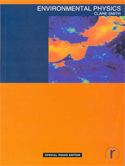
|
Environmental Physics (Indian Reprint 2012) - Clare Smith |
|
|
Cover Price : Rs 695.00
|
Imprint : T & F / Routledge
ISBN : 9780415201919
YOP : 2012
|
Binding : Paperback
Total Pages : 304
CD : No
|
|
DESCRIPTION
Poor background in physics is a problem facing many students and professionals in geomorphology and related sciences. Clare Smiths admirable and worthwhile text covers a very wide range of topics and is directly aimed at this market. - Nicholas J. Cox, Department of Geography, University of Durham reviews for Wiley Interscience, 2002
Environmental Physics is a comprehensive introduction to the physical concepts underlying environmental science. The importance and relevance of physics is emphasised by its application to real environmental problems with a wide range of case studies. Applications included cover energy use and production, global climate, the physics of living things, radioactivity, environmental remote sensing, noise pollution and the physics of the Earth. The book makes the subject accessible to those with little physics background, keeping mathematical treatment straightforward. The text is lively and informative, and is supplemented by numerous illustrations, photos, tables of useful data, and a glossary of key terms.
CONTENTS
Part 1: The Forces of Nature 1.1: Fundamentals: Newtonian Mechanics; 1.2: Gravity; 1.3: Rotational Dynamics and Angular Momentum; 1.4: Waves; 1.5: Electro-magnetism Part 2: Energy 2.1: Energy, Efficiency and Entropy; 2.2: Mechanical Work - Forces and Energy; 2.3: Electrical Energy; 2.4: Renewable Energy; 2.5: Energy Use in Transport; 2.6: Energy in the Biosphere Part 3: Heat and Radiation 3.1: Heat and Temperature; 3.2: Thermal Expansion; 3.3: Transmission of Heat; 3.4: Engines and Thermal Power Production; 3.5: Radiation: The Electromagnetic Spectrum; 3.6: Remote Sensing Part 4: Solids, Liquids and Gases 4.1: Fundamentals: States of Matter; 4.2: Properties of Solids; 4.3: Pressure; 4.4: Gases; 4.5: Fluids and Fluid Flow; 4.6: Hydrology and hydrogeology Part 5: The Earths Climate and Climate Change 5.1: The Earths Climate; 5.2: Climate Change Part 6: Sound and Noise 6.1: Sound Waves; 6.2: Noise and Noise Nuisance Part 7: Radioactivity and Nuclear Physics 7.1: Nuclear Physics; 7.2: Biological Impacts of Ionizing Radiation; 7.3: Radioactive Decay; 7.4: Nuclear Fission Reactions; 7.5: Fusion Reactions.
|
|
 |

|
Environmental Modelling : An Introduction - Jo Smith |
Author |
Jo Smith
Peter Smith
|
|
Cover Price : Rs 495.00
|
Imprint : Oxford University Press
ISBN : 0199272069
YOP : 2008
|
Binding : Paperback
Total Pages : 192
CD : No
|
|
About the Book :-
The global environment is a complex mix of interlinked processes, about which observation can tell us a great deal. But how can we use current observation to model future events, or to predict the consequences of scenarios that don't yet exist?
Environmental Modelling: An Introduction shows how modelling can be used to explain experimental observations, and how these observations - and the data gathered - can be extrapolated to help us understand new environments and processes, and to solve environmental problems.
The book begins by explaining why modelling is such a powerful experimental tool, before walking the reader through the process of constructing a model - what the key considerations are, and how different models should be used to probe different types of problem. It then illustrates how models are actively applied, before introducing a series of case studies to show how modelling has been used in real environmental and ecological studies.
Accompanied by an extensive Online Resource Centre to support active, hands-on learning on the part of the student, Environmental Modelling: An Introduction is the ideal resource for any student who needs to develop a working understanding of modelling, and how to apply modelling in their own research.
Contents :-
1. Introduction
2. Model Development
3. Model Evaluation
4. Application of Models
5. Environmental and Ecological Models in the Real World
About the Authors :-
Jo Smith, Reader in Soil Organic Matter and Nutrient Modelling, School of Biological Sciences, University of Aberdeen and
Pete Smith, Professor of Soils and Global Change, School of Biological Sciences, University of Aberdeen. |
|
 |
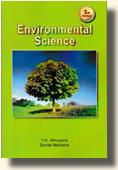
|
Environmental Science, 2nd ed - V K Ahluwalia |
Author |
V K Ahluwalia
Sunita Malhotra
|
|
Cover Price : Rs 1,495.00
|
Imprint : Ane Books Pvt. Ltd.
ISBN : 9789384726867
YOP : 2021
|
Binding : Hardbound
Total Pages : 376
CD : No
|
|
About the Book :-
The main thrust of this book is on the chemistry of environmental processes and pollutants. In addition to this, a wide coverage on various others aspects of environment is purposely included to make it relevant for a large number of students studying chemistry, environmental sciences, life science, engineering and other disciplines at undergraduate and post graduate level. The interdisciplinary approach makes the book quite informative and interesting for all readers.
The contents cover the topics suggested in the syllabii of several universities at undergraduate and postgraduate levels.
A special feature of this book is that the environmental issues have been dealt from the global perspective in general and with the Indian focus, in particular. The data included has been obtained from the original and reliable sources which we gratefully acknowledge. The latest and current information for various environmental parameters have been included. Thus, this book aims to serve the students of all Indian and other universities.
Finally, the style is reader friendly and the language is quite simple and lucid. A lot of illustration have been included to make the subject matter easily understandable. To facilitate the readers, an index of contents and the glossary have also been incorporated.
Contents :-
1. Energy and Environment 2. Environment 3. Atmosphere 4. Air Pollution 5. Water 6. Water Pollution 7. Marine Pollution 8. Soil 9. Soil Pollution 10. Hazardous Waste and its Management 11. Noise Pollution 12. Environment and Health 13. Climate Change 14. Biodiversity 15. Environmental Management 16. Some Case Studies 17. Towards Cleaner Future, Glossary, Index.
About the Authors :-
V.K. Ahluwalia has worked as professor of Chemistry, University of Delhi, Delhi for more than three decades and taught Graduate, Postgraduate and M.Phil. students. He has guided about 70 students for M.Phil./Ph.D.degrees and has published more than 250 research papers in National and International Journals.He has delivered a number of invited lectures in India and Abroad.
Prof. Ahluwalia worked as Post-doctoral Fellow for two years (1960-1962) and worked with Prof. Harold Shechter at the Department of Chemistry. Ohio State University, Ohio, USA and for one year (1980-81) with Professor Herbert C. Brown, Nobel Laureate at the Dept of Chemistry, Purdue University, USA.
He has also been a Visiting Professor at Dr.B.R.Ambedkar Centre for Biomedical Research University of Delhi, Delhi.
Prof. Ahluwalia is author of a number of books on Reaction Mechanism, Green Chemistry, Environmental Chemistry and Organic Synthesis.
Sunita Malhotra, Professor of School of Science at IGNOU, is Gold Medalist in PG Diploma in Distance Education. She is involved in the curriculum design and development of course materials for distance and open learners using multiple media. She is actively engaged in the training of teachers, counselors and other human resources in the field of chemistry, environmental education and distance education. She has been a resource person in development of course materials for NCERT, NIOS and Sarva Shiksha Abhiyan for various states. |
|
 |

|
Environmental Science and Technology, 2nd ed - Stanley E. Manahan |
Author |
Stanley E. Manahan
|
|
Cover Price : £ 54.99
|
Imprint : T & F / Routledge
ISBN : 9780367390129
YOP : 2019
|
Binding : Paperback
Total Pages : 672
CD : No
|
|
DESCRIPTION
Formally established by the EPA nearly 15 years ago, the concept of green chemistry is beginning to come of age. Although several books cover green chemistry and chemical engineering, none of them transfer green principles to science and technology in general and their impact on the future. Defining industrial ecology, Environmental Science and Technology: A Sustainable Approach to Green Science and Technology, Second Edition provides a general overview of green science and technology and their essential role in ensuring environmental sustainability.
Written by a leading expert, the book provides the essential background for understanding green science and technology and how they relate to sustainability. In addition to the hydrosphere, atmosphere, geosphere, and biosphere traditionally covered in environmental science books, this book is unique in recognizing the anthrosphere as a distinct sphere of the environment. The author explains how the anthrosphere can be designed and operated in a manner that does not degrade environmental quality and, in most favorable circumstances, may even enhance it.
With the current emphasis shifting from end-of-pipe solutions to pollution prevention and control of resource consumption, green principles are increasingly moving into the mainstream. This book provides the foundation not only for understanding green science and technology, but also for taking its application to the next level.
CONTENTS
1. SUSTAINABLITY THROUGH GREEN SCIENCE AND TECHNOLOGY
2. THE GIVE ENVIRONMENTAL SPHERES
3. GREEN CHEMISTRY, BIOLOGY, AND BIOCHEMISTRY
4. WATER: A UNIQUE SUBSTANCE ESSENTIAL FOR LIFE
5. AQUATIC BIOLOGY, MICROBIOLOGY, AND CHEMISTRY
6. KEEPING WATER GREEN
7. THE ATMOSPHERE: A PROTECTIVE BLANKET AROUND US
8. ENVIRONMENTAL CHEMISTRY OF THE ATMOSPHERE
9.SUSTAINING AN ATMOSPHERE FOR LIFE ON EARTH
10. THE GEOSPHERE
11. SOIL, AGRICULTURE, AND FOOD PRODUCTION
12. GEOSPHERIC HAZARDS AND SUSTAINING A GREEN GEOSPHERE
13. THE BIOSPHERE: ECOSYSTEMS AND BIOLOGICAL COMMUNITIES
14. TOXIC EFFECTS ON ORGANISMS AND TOXICOLOGICAL CHEMISTRY
15. BIOPRODUCTIVITY FOR A GREENER FUTURE
16. THE ANTHROSPHERE AS PART OF THE GLOBAL ENVIRONMENT
17. INDUSTRIAL ECOLOGY FOR SUSTAINABLE RESOURCE UTILIZATION
18. ADEQUATE, SUSTAINABLE ENERGY: KEY TO SUSTAINABILITY
INDEX |
|
 |
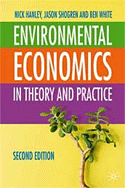
|
Environmental Economics in Theory and Practice - 2 Ed. - Nick Hanley |
Author |
Nick Hanley
Jason F. Shogren
Ben White
|
|
Cover Price : £ 7.99
|
Imprint : Palgrave / Macmillan
ISBN : 0230327238
YOP : 2009
|
Binding : Paperback
Total Pages : 480
CD : No
|
|
About the Book :-
Environmental Economics in Theory and Practice is an ideal text for students taking advanced courses in environmental and natural resource economics. This completely revised and updated edition covers all the major topics in the field, including the economics of sustainable development, market failure and mechanism design, pollution taxes and tradable permits, trans-boundary pollution, non-renewable and renewable resources (including both fisheries and forests), environmental valuation, risk, and trade and the environment. The authors make extensive use of mathematical models, supplementing these with careful explanation and graphical analysis. Emphasis is placed on the application of economic analysis to real-world environmental problem solving, such as designing policies to control pollution or to reduce global biodiversity loss, and examples are drawn from all over the world.
Contents:-
List of tables
List of figures
List of boxes
Introduction and acknowledgements
1. Economy - Environment Interactions
2. Sustainable Development
3. Market Failure
4. Incentive Design
5. Emission Taxes and Tradable Emission Permits: Theory into Practice
6. Transboundary and Global Pollution
7. Nonrenewable Resources: Market Structure and Policy
8. Nonrenewable Resource Scarcity, Costs, and Externalities
9. Biological Natural Resources: the Fishery
10. Forestry Economics
11. Theory and Methods for Environmental Valuation
12. Environmental Risk
13. Trade and the Environment
Author Index
Subject Index.
About the Authors :-
NICK HANLEY is Professor of Environmental Economics at the University of Stirling, Scotland.
JASON F. SHOGREN is Stroock Distinguished Professor of Natural Resource Conservation and Management at the University of Wyoming, USA.
BEN WHITE is Senior Lecturer in Agricultural and Resource Economics at the University of Western Australia, Australia.
The authors have also jointly produced An Introduction to Environmental Economics (Oxford University Press, 2001). Nick Hanley is the author of Cost-Benefit Analysis and the Environment (Edward Elgar, 1994). |
|
 |
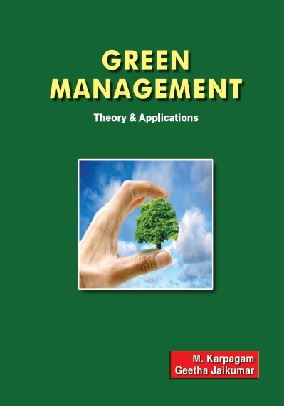
|
Green Management : Theory and Applications - M. Karpagam |
|
|
Cover Price : Rs 1,995.00
|
Imprint : Ane Books Pvt. Ltd.
ISBN : 9789385166730
YOP : 2023
|
Binding : Hardbound
Total Pages : 428
CD : No
|
|
About the Book
This book introduces the students and management practitioners to green thinking, ethical management practices, pollution control and prevention, as well as strategies that could be adopted to convert an environmental problem into business opportunity for companies.
Contents
Foreword, Preface 1. Environmental Philosophies and Environmental Ethics 2. Basics of Ecology and Environment 3. Environmental Movement 4. Business Ethics and Its Relevance Today 5. Economics-Environment Interlinkages 6. Economic Development and Environmental Degradation 7. Economics of Pollution 8. Sustainable Development 9. The Rise of Green Consumerism 10. The Greening of Company Managements 11. Environmental Management Systems in Industry 12. Stakeholders and Their Relevance Today 13. The Precautionary Principles 14. The Polluter Pays Principles 15. Sustainable Industrialization 16. Industrial Ecology 17. Economic Theory of Pollution Control - I: Optimum Pollution and Pollution Control Policy Measures 18. Pollution Control Policy - II: Command and Control 19. Pollution Control Policy - III: Taxes and Subsidies 20. Pollution Control Policy - IV: Transferable Discharge Permits and Refundable Deposits 21. Comparison of Pollution Control Policy Instruments 22. Life Cycle Analysis and Cradle to Cradle Concept of Industrial Design 23. Environmental Management Accounting 24. Environmental Auditing 25. Environmental Impact Assessment 26. Environmental Certifications 27. Environmental Marketing 28. India's Pollution Control Policy, Glossary, Bibliography, References Websites
About the Authors
Dr.M.Karpagam is an Associate Professor in the Department of Economics, Meenakshi College for Women, Chennai. She has obtained her doctorate in the area of Environmental Policy. She has authored first Indian textbook on environmental economics and environmental management- Environmental Economics: A Textbook (1992). She has research and consultancy experience in environmental policy issues.
Dr.Geetha Jaikumar has obtained her doctorate in the area of Industrial Pollution Control in Tamil Nadu. She is an Associate Professor of Commerce working at Meenakshi College for Women, Chennai.
|
|
 |
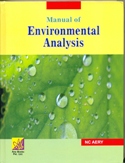
|
MANUAL OF ENVIRONMENTAL ANALYSIS, 2016 - N.C. AERY |
|
|
Cover Price : Rs 1,995.00
|
Imprint : Ane Books Pvt. Ltd.
ISBN : 9789380156217
YOP : 2015
|
Binding : Hardbound
Size : 7.25
Total Pages : 424
CD : No
|
|
About the Book
The present volume is a compilation of some tested and widely used methods of characterizing soil, plant, air and water. The main objective of the book is to make available the hitherto scattered information in literature in a single volume. The information is not readily available to students, research scholars and even teachers. Most of the methods have been well tested in the laboratory of the author during the last 33 years of research
The book attempts to combine the features of both a textbook and a reference handbook. Keeping in view the available facilities in most of our colleges and universities, care has been taken to present simple and most inexpensive methods in a simple and lucid language, so that they can easily be understand and used. In each method the principle involved, the materials/reagents required, the methods of their preparation and calculation of results have been described.
The book covers a wide range of topics such as physical, chemical, biological and microbiological examination of water and wastewaters; physical, chemical and microbiological examination of soils; analysis of plant materials, analysis of air, and measurement of noise etc. Emphasis has also been given on some important aspects of pollution assessment such as Bioassay, Environmental radioactivity and its monitoring, Biomonitoring, Environmental impact Assessment, Environmental Auditing, Indoor Air Pollution etc.
Contents
1. Physical and Chemical Examination of Water and Waste Water 2. Biological Examination of Waste Water 3. Microbiological Examination of Water 4. Physico-Chemical Examination of Soil 5. Microbiological Examination of Soil 6. Environmental Radioactivity Monitoring 7. Bioassay 8. Analysis of Plant Material 9. Analysis of Air 10. Measurement of Noise 11. Effect of Pollutants on Plants 12. Biomonitoring 13. Vegetation Analysis 14. Environmental Impact Assessment (EIA) 15. Environmental Auditing 16. Statistics in Environmental Science,Bibliography, Annexures, Index
About the Author
Prof.N.C.Aery is Professor of Botany and formerly the Head, Dept. of Botany & Associate Dean, University College of science, Mohanlal Sukhadia University, Udaipur, Rajasthan, India. For the last 33 years or so, he is engaged in teaching environmental sciences and taxonomy of higher plants to the postgraduate and undergraduate students. His research interest included different areas in plant Sciences namely, Geobotany and Biogeochemistry of Mineral Deposits, Phytoremediation, Biomonitoring, Ecotoxicology and Biodiversity of higher plants. He is pioneer in India in the field of Geobotany and Biogeochemistry and has studied the mineral deposits of Pb, Zn, Cd, W and lately Uranium. Dr.Aery has visited different countries to attend conferences and training programmes, has published about 115 research papers in National and International journals of repute, has successfully completed 10 major research projects funded by various agencies and authored/edited 11 books. Twenty five students have completed their Ph.D and 04 are pursuing research work under his guidance. Presently, his group is pursuing studies on the environmental monitoring of naturally occurring radionuclides essentiality toxicity of Si, La, Ce, W and U in plants, phytoremediation of mining wastelands integrating Remote Sensing and GIS technology and relative agronomic evaluation of certain phosphatic fertilizers.
|
|
 |
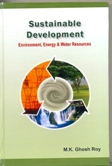
|
Sustainable Development, Indian Reprint - M.K.Ghosh Roy |
|
|
Cover Price : Rs 1,995.00
|
Imprint : Ane Books Pvt. Ltd.
ISBN : 9789380156736
YOP : 2021
|
Binding : Hardbound
Total Pages : 384
CD : No
|
|
About the Book
The over-exploitation of the earth’s resources has brought about an unsustainable situation when the biodiversity and ecological balance are under dire threat. But the most immediate concern is the global warming, caused by high anthropogenic emission of carbon dioxide in the atmosphere. The global warming is upsetting the climate pattern. The climate change is threatening the earth with severe drought and flood, storm and cyclone, rise in the sea level arising out of general warming of sea water and also by glacial and Arctic ice melting, inundation of low coastal areas by the rising sea, disruption in the agricultural crop pattern, serious problem with regard to availability of fresh water, etc.
With the prescience of all these serious challenges facing the earth cataclysmically, the book attempts to engage the learned, the researchers, the graduate students, the social activists in the studies of the challenges of "Environment, Energy and Water Resources" and work for the mitigation of and adaptation with the global warming and climate change.
Contents
Part I: Overview of Sustainable Development, 1. Global Sustainability-An Overview 2. Multi-Sectoral Resources Review Towards Sustainability, 3. Technology Solution for Global Sustainability, 4. Economic & Governance of Sustainable Development, Part II: Challenges of Environment, 5. General Atmospheric Pollution, 6. Automobile Emissions, 7. Depletion of Ozone Layer, 8. Problem of Acid Rain, 9. Global Warming & Climatic Changes, 10. Carbon Emission Scenario, 11. Climate Change & Carbon Trading, Part III: Challenges of Energy, 12. Global Energy Challenges, 13. Nuclear Energy, 14. Biomass Energy, 15. Solar Energy-A Promising Alternative Power Source, 16. Wind Energy & Power, 17. Fuel Cells & Hydrogen Fuel Technology, 18. Hydro-Energy, 19. Other Energy Challenges, Part IV: Challenges of Water Resources, 20. Overview of Global Water Resources, 21. Challenges of India’s Water Resource, 22. Indian Water Resources II, 23. Urban Water Supply-A Dual Water System.
References
Index
About the Author
Prof. M.K.Ghosh Roy, after obtaining his B.Tech.(Hons) in Naval Architecture from IIT, Kharagpur and Ph.D. in Mechanical Engineering from the Bombay University, worked for three decades in design and engineering, publishing large number of papers in India and abroad in the Transaction of Royal Institution of Naval Architects, London and Japan. He served the industry in the senior management, till he was invited to become a senior Professor at IIT Madras. The call of social responsibility weighed heavily on him and he eventually switched over to the realm of Environmental Science and Engineering in the last two decades.
|
|
 |
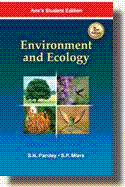
|
Environment and Ecology, 2nd Edn - S.N. Pandey |
Author |
S.N. Pandey
S.P. Misra
|
|
Cover Price : Rs 2,995.00
|
Imprint : Ane Books Pvt. Ltd.
ISBN : 9789385166396
YOP : 2023
Edition : 2023
|
Binding : Hardbound
Size : 6.25" X 9.50"
Total Pages : 538
CD : No
|
|
About the Book:
This is a completely revised and updated edition with instant approach. Latest information has been provided on topics like Ecosystems, Ecological Pyramids, Ecological Productivities, Biodiversity Conservation, Sustainable Development, Endemism, Hot Spots of Vegetation in India, Global Cooling, El Nina and LA Nina and on various problems associated with Environmental Pollution and Case studies etc. New chapters like Phytogeography of India, Afforestation, Social Forestry and Agro-forestry, Ecological Factors (Climatic, Edaphic, Topographic, Biotic etc.), Ecological Groups and their Adaptations, Concept of Ecosystems, Community Dynamics, Characteristics of Community, Population Dynamics, Practical Exercises on Ecology and Environmental Pollution offer special attractions and completeness of the subject. While accompanying all such features, additional information in Special boxes and updated Environmental Calendar make the book incredibly valuable.
Contents:
1. Environmental Studies: An Introduction 2. Natural Resources and Energy Resources 3. Water Resources 4. Forest Resources 5. Phytogeography of India 6. Biodiversity 7. Threats to Biodiversity 8. Endemism and Hot Spots of Vegetation in India 9. Conservation of Biodiversity 10. Sustainable Development 11. Afforestation, Social-forestry and Agro-forestry 12. Introduction to Ecology 13. Ecological Factors: Climatic Factors 14. Soil or Edaphic Factors 15. Topographic Factors and Biotic Factors 16. Ecological Groups and Adaptations 17. Concept of Ecosystem 18. Structure and Functions of Ecosystem 19. Producers, Consumers and Decomposers 20. Energy Flow in Ecosystem 21. Food Chains, Food Webs and Ecological Pyramids 22. Various Ecosystems 23. Ecological Succession (Community Dynamics) 24. Characteristics of Community 25. Population Dynamics 26. Pollution: An Introduction 27. Air Pollution 28. Water Pollution 29. Water Borne and Water Induced Diseases and Fluoride Problem in Drinking Water 30. Soil Pollution 31. Marine Pollution 32. Noise and Thermal Pollution and Nuclear Hazards 33. Pollution Case Studies34. Select Environment Issues 35. Consumerism and Environmental Protection 36. Environment Protection Acts.
About the Authors:
Dr. S N Pandey, formerly Assoc. Prof., Department of Botany, DAV College, CSJM University, Kanpur, has to his credit over 30 reputed books, 70 research papers published in Indian and foreign journals. He has attended and co-organised several National and International conferences, including Millennium Wetland Event, 2000, Quebec, Canada and has so far visited over 20 countries. He has guided five Ph.Ds on variety of issues related to aquatic environmental problems. Essential Environmental Studies and Taxonomy of Angiosperms are his famous books on related topics.
Prof. S.P. Misra, formerly Sr. Reader, Biopollution Study Centre, Department of Botany, Christ Church College, C.S.J.M. University, Kanpur, has a long experience of teaching Botany and Environmental Sciences. He has attended several national and international conferences on Environment including paper presentation at Millennium Wetland Event-2000 at Canada. He is author of books Essential Environmental Studies, Taxonomy of Angiosperms and Plant Tissue Culture. |
|
 |
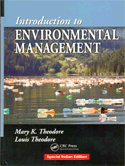
|
Introduction to Environmental Management - Mary K. Theodore |
Author |
Mary K. Theodore
Louis Theodore
|
|
Cover Price : Rs 3,500.00
|
Imprint : CRC Press
ISBN : 9781138581661
YOP : 2019
|
Binding : Hardbound
Size : 6.25" X 9.50"
Total Pages : 572
CD : No
|
|
It is hard to imagine an area of study or a discipline in which a basic knowledge of the issues would not be beneficial, since environmental concerns are very much in the public consciousness. Written at a level that is accessible to students in all disciplines, Introduction to Environmental Management translates complex environmental issues into understandable terms
Features:
• Provides information on advanced environmental issues to technical and non-technical audiences in easy-to-understand terms
• Includes coverage of pressing environmental management issues, regulations, types of pollutants, and remediation strategies
• Discusses the environmental implications of nanotechnology, global climate change, and electromagnetic fields
• Explains the emerging ethical issues in environmental management
• Covers energy conservation, waste reduction, public health, safety, and accident prevention
Overview
Introduction to Environmental Issues
Environmental Regulations International Regulations
ISO 14000
Multi-media Concerns
Classication and Sources of Pollutants
Effects of Pollutants
Green Chemistry and Green Engineering
Sustainability
Air
Air Pollution Control Equipment
Atmospheric Dispersion Modeling
Greenhouse Effect and Global Warming
Air Toxics
Indoor Air Quality
Vapor Intrusion
Water
Water Chemistry
Safe Drinking Water
Municipal Wastewater Treatment
Industrial Wastewater Management
Dispersion Modeling in Water Systems
Acid Rain
Solid Waste
Municipal Solid Waste Management
Industrial Waste Management
Hospital Waste Management
Nuclear Waste Management
Underground Storage Tanks
Superfund
Asbestos
Metals
Pollution Prevention
The Pollution Prevention Concept
Pollution Prevention Applications
Introduction to Health, Safety, and Accident Management
Health, Safety, and Accident Management Application
Introduction to Energy Conservation
Energy Conservation Applications
Architecture in the Environment: History, Practice, and Change
Environmental Risk
Introduction to Environmental Risk Assessment
Health Risk Assessment
Hazard Risk Assessment
Public Perception of Risk
Risk Communication
Other Areas of Interest
The EPA Dilemma
Electromagnetic Fields
Noise Pollution
Used Oil
Environmental Audits
Economics
Environmental Implications of Nanotechnology
Environmental Ethics
Environmental Justice
|
|
 |
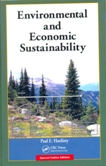
|
Environmental and Economic Sustainability - Paul E.Hardisty |
|
|
Cover Price : Rs 3,995.00
|
Imprint : CRC Press
ISBN : 9781420059489
YOP : 2015
|
Binding : Hardbound
Total Pages : 338
CD : No
|
|
Never before has the quest to balance the needs of people, the environment, and the economy been so important. While sustainability has been widely taken up by governments and business, the world has continued to move in increasingly unsustainable directions, from continued dependence on fossil energy to rising greenhouse gas emissions, and erosion of biodiversity. We know what the right thing to do is, but somehow we cannot make the changes that are needed, and so we continue with business as usual, producing business-as-usual results.
Based on more than fifteen years of research and practice, Environmental and Economic Sustainability introduces the environmental and economic sustainability assessment (EESA), a new way to make decisions that meets the challenges of the 21st century. Incorporating elements of life-cycle analysis, risk assessment, cost-benefit analysis, and comprehensive sensitivity analysis, EESA provides a fully quantitative, objective, and rational way to include all of the social, environmental, and economic issues relevant to a decision into one comprehensive analysis. The author demonstrates how to apply EESA using examples across a number of major industries, including petroleum, mining, and public utilities, and covering key issues such as water, greenhouse gases, waste, contaminated sites, and renewable energy.
Ultimately, the solutions to problems of the 21st century will come from understanding the tremendous value that the environment provides, and reflecting that value within decision-making at every level so that society as a whole thrives. This book demonstrates that while business-as-usual approaches can be sub-optimal, spending on sustainable outcomes must be balanced with anticipated benefits. It demonstrates how to communicate with stakeholders in a transparent process which provides a robust view of how various options compare over a wide range of possible future conditions, using a language that everyone understands: money.
Contents
Introduction
The Exponential Era
Crisis—Which Crisis?
True Sustainability for This Century
Objectives and Structure of the Book
Notes
Sustainability in the Twenty-first Century
A Short History of Sustainability
The Challenges of the Twenty-first Century
An Overview of Global Trends
Why Sustainability Has Not Worked
The Twentieth-Century Prosperity Explosion
Twentieth-Century Engineering
Twenty-First Century Economics for the Twenty-First Century
Conclusion
Notes
Quantifying Sustainability for Improved Decision Making
Balancing Environment, Society, and Economy
The Environmental and Economic Sustainability Assessment: Embedding Sustainability in Decision Making
Socioenvironmental Economic Analysis
Full Social Cost–Benefit Analysis
Valuing the Environment and Society
Applying the Environmental and Economic Sustainability Assessment
Examples
Notes
Water
Introduction
Water Management in Industry: Overview
Water Use and Protection in Oilfield Development in North Africa
Produced Water Management in Oilfield Operations
Water Management in Mine Development
Example: Determining a Sustainable Wastewater Treatment and Discharge Strategy
Summary
Notes
Greenhouse Gases and Climate Change
Introduction
Carbon Mitigation Risk
Adaptation Risks
Example: GHG Management in Heavy Oil Production
Summary
Notes
Energy
Introduction
Example: Commercial-Scale Solar Thermal Power in Australia
Example: Comparing Renewable Energy Options
Summary
Notes
Contaminated Sites and Waste
Introduction
Conceptual Framework
The Economics of Remediation
Economic Sustainability Analysis for Contaminated Land
The Social Cost of Waste Management Using Landfill
Case History: Brownfield Redevelopment in Canada
Case History: Groundwater Remediation at a Refinery in Europe
Remediating NAPLs in Fractured Aquifers
Example: DNAPL in a Fractured Carbonate Aquifer, United States
Example: NAPL in a Fractured Carbonate Aquifer, United Kingdom
Discussion
Notes
Best Practice for the Twenty-first Century
Summary
Technology
Management and Decision Making
Into the Future
Notes
Index
|
|
 |

|
Fundamentals of Practical Environmentalism - Mark B.Weldon |
|
|
Cover Price : Rs 2,995.00
|
Imprint : CRC Press
ISBN : 9781439849286
YOP : 2015
|
Binding : Hardbound
Total Pages : 220
CD : No
|
|
Environmental decisions present themselves every day in forms large and small. Should I walk to work today? What about global warming—should I write my congressperson and demand that the government do something? Should I put solar panels on my roof? Should I get a different car or turn up the temperature on the air conditioner or get water-saving fixtures for my bathroom? As environmentalism has become more complex, with potentially far-reaching impacts, it seems to be outpacing our individual understanding of the basic issues.
A fresh view of modern environmentalism, Fundamentals of Practical Environmentalism challenges readers to integrate concern for the environment with the necessities of daily living. This book introduces practical environmentalism as a new approach to sustainable environmental progress. It presents a four-part framework that includes environmental degradation, resource conservation, economic progress, and personal benefit as the four pillars to address when attempting to act on behalf of the environment.
The book consists of three main sections. Looking at historical and ethical perspectives, the first section examines the theoretical basis for practical environmentalism. The second section explains each of the four pillars in detail and demonstrates how to combine them into a holistic metric that guides environmental actions. The final section presents a number of case studies that run the gamut from small personal choices to the biggest and most contentious environmental dilemmas of the day. It shows how practical environmentalism via the four pillars can lead individuals toward better environmental decisions and an improved chance for true environmental progress.
This timely and practical book will be of use to activists, policymakers, researchers, resource managers, government agencies, and students alike, as well as anyone confronted with environmental choices in their daily lives.
Contents
1. An Introduction to Practical Environmentalism and the Four Pillars
2. A Short History of Environmentalism in the United States
3. The Ethics of Environmentalism
Issue-Driven Environmentalism
Process-Based Environmentalism
Regulatory Environmentalism
Protest Environmentalism
Perspective-Based Environmentalism
The Nonbeliever
The Live Earth
Spaceship Earth
Back to Nature
Doomsday
Anticonsumption
Cornucopia
4. The Confounding Factors
Competing Objectives
Uncertainty
Measures of Success
Fallacy of Prediction
Assumption of Future States
The Problem with Percentages
History of Paranoia
Crisis Mentality
5. Environmental Degradation—The First Pillar
6. Resource Conservation—The Second Pillar
7. The “Human” Pillars of Economic Progress and Personal Benefit
Economic Progress
Personal Benefit
8. Scoring with the Pillars—A Few Simple Examples to Illustrate the Method
9. The Pillars in Daily Life
10.The Pillars and the Really Big Issues
11More Really Big Issues—The Sacrificial Ones
12.The Pillars and Global Warming
13.Other Measures of Environmental Performance
Carbon Footprint
Carrying Capacity
Life-Cycle Costing
Government and Scientific Reports
Green Accounting—ISEW (Index of Sustainable Economic Welfare)
Simple Monetary Economics
Some Final Thoughts
Index
|
|
 |
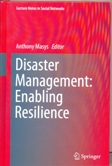
|
Disaster Management: Enabling Resilince - Anthony Masys |
|
|
Cover Price : € 129.99
|
Imprint : Springer
ISBN : 9783319088181
YOP : 2015
|
Binding : Hardbound
Total Pages : 354
CD : No
|
|
The present work will discuss relevant theoretical frameworks and applications pertaining to enabling resilience within the risk, crisis and disaster management domain. The contributions to this book focus on resilience thinking along 4 broad themes: Urban Domain; Cyber Domain; Organizational/Social domain; and Socio-ecological domain. This book would serve as a valuable reference for courses on risk, crisis and disaster management, international development, social innovation and resilience. This will be of particular interest to those working in the risk, crisis and disaster management domain as it will provide valuable insights into enabling resilience. This book will be well positioned to inform disaster management professionals, policy makers and academics on strategies and perspectives regarding disaster resilience.
Contents
Part 1.- 1. Resilience Undefined. A Framework for Interdisciplinary Communication and Application for real; World Problems; T.G. Koslowski, P.H. Longstaff.- 2. Disaster Management, control and resilience; E. Hollnagel.- Part 2. Urban Domain.- 3. Futuristic smart architecture for a rapid disaster response; O. Chikumbo et al.- 4. Building in resilience. Long-term considerations in the design and production of residential buildings in Israel; M. Sever, Y Garb, D. Pearlmutter.- 5. Urban Resilience & Sustainability. The role of a local resilience forum in England; J. Fisher et al.- 6. Wicked Problems Framework. Architectural Lessons from recent urban disasters; A. JaYeun Lee.- Part 3. Cyber Domain.- 7. Architectures for Cyber-Security Incident Reporting in Safety-Critical Systems; Chris W. Johnson.- 8. The Cyber-ecosystem. Enabling resilience through the Comprehensive Approach; A. J. Masys.- Part 4. Organizational/ Social Domain.- 9. Enabling Resilience. An examination of high reliability organizations and safety culture through the lens of Appreciative Inquiry; J. Wattie, A.J. Masys.- 10. Unintended Consequences. What lessons can risk-managers learn from the use of armed Remotely Piloted Vehicles for counter-insurgency in Pakistan?; S. Bennett.- 11. Extra-fragile in disaster. People with disabilities in a bombarded zone; R. Sever.- 12. The application of quality of life metrics; R. Potangaroa et al.- 13. Defining and negotiating a shared responsibility for disaster resilience; B. Wilson.- Part 5. Socio-ecological Domain.- 14. Wildland Fire Management. Movement towards enabling resiliency?; M.R. Czaja.- 15. Case-Study. Vulnerabilities co-evolutionary dynamics in Morelia Michoacan, Mexico; L. Aguilar-Armendariz, A.N. Martinez-Garcia.
|
|
 |
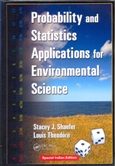
|
Probability and Statistics Applications for Environmental Science - Stacey J.Shaefer |
Author |
Stacey J. Shaefer
Louis Theodore
|
|
Cover Price : Rs 4,995.00
|
Imprint : CRC Press
ISBN : 9780849375613
YOP : 2015
|
Binding : Hardbound
Total Pages : 392
CD : No
|
|
Simple, clear, and to the point, Probability and Statistics Applications for Environmental Science delineates the fundamentals of statistics, imparting a basic understanding of the theory and mechanics of the calculations. User-friendliness, uncomplicated explanations, and coverage of example applications in the environmental field set this book apart.
Striking a balance between theory and applied mathematics, the material is divided into three parts. Part I sets the stage with coverage of principles and fundamentals, such as set notation, probability distributions, and the estimation of the mean and variance. Part II discusses traditional statistics applications, centering around the uses of probability distributions, including how they relate to reliability and failure theory. The authors elucidate many of the important distributions, Monte Carlo methods, and fault and event trees. Part III delves into what some have come to define as contemporary statistics. It covers hypothesis testing, Student's t and chi-square tests, regression analysis, analysis of variance (ANOVA), and nonparametric tests. An introduction to Design of Experiments is provided in the Appendix.
The book's coverage is thorough, its presentation logical and geared to student's needs as well as the needs of statistics/probability challenged professionals. The authors, known for their meticulously accurate, articulate, and practical writing style, master the difficult task of explaining very complicated subject matter in a way that is easily understood.
Contents
FUNDAMENTALS
PAC. Permutations and Combinations
PDI. Probability Definitions and Interpretations
SNE. Set Notation
BTH. Basic Theorems
COP. Conditional Probability
RAR. Random Variables and Random Numbers
PDF. Introduction to Probability Distributions
EXV. Expected Values
EMV. Estimation of Mean and Variance
TRADITIONAL APPLICATIONS
BAY. Bayes' Theorem
SPS. Series and Parallel Systems
BIN. The Binomial Distribution
REL. Reliability Relations
HYP. Hypergeometric Distribution
POI. Poisson Distribution
EXP. Exponential Distribution
WBL. Weibull Distribution
NOR. Normal Distribution
LOG. Log-Normal Distribution
MON. Monte Carlo Simulation
FET. Fault Tree and Event Tree Analysis
CONTEMPORARY APPLICATIONS
CIM. Confidence Intervals for Means
CIP. Confidence Intervals for Proportions
HYT. Hypothesis Testing
TMP. Hypothesis Test for Means and Proportions
CHI. Chi-Square Distribution
FFF. The F Distribution
REG. Regression Analysis: Method of Least Squares
NPT. Nonparametric Tests
ANV. Analysis of Variance
Appendix A: Appendix A and Tables
Appendix B: Glossary of Terms
Appendix C: Introduction to Design of Experiments
Index
|
|
 |
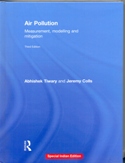
|
Air Pollution, 3rd Ed - Abhishek Tiwary |
Author |
Abhishek Tiwary
Jeremy Colls
|
|
Cover Price : Rs 5,495.00
|
Imprint : T & F / Routledge
ISBN : 9780415479332
YOP : 2015
|
Binding : Hardbound
Total Pages : 522
CD : No
|
|
Contents
Acronyms and abbreviations
Preface
Air Pollutants: Sources and Control of Gases
Units for Expressing Pollutant Concentration
The Basic Atmosphere
The Vertical Structure of the Atmosphere
Anthropogenic Emissions
Primary Emission Summary
Adsorption and Adsorption of Gases
Other Air Pollutants
Secondary Gaseous Pollutants
Emission Interventions
Air Pollutants: Particulates
Particle Terminology
Particle Size Disturbations
Aerosol Mechanics
Particle Sources
Abatement of Primary Particle Emissions
Secondary Particles
Trends in Particle Emissions
Mobile Sources
Motor Vehicle Emissions
Train Emissions
Shipping Emissions
Aircraft Emissions
Different Models of Transport
Measurement of Gases and Particles
Methods of Describing Pollutant Concentration
Sampling Requirements
Gas Sampling
Gas Concentration Measurement
Quality Control
Particle Sampling
Particle Measurement Methods
Chemical Composition of Aerosol
Measurement of Course Particle Deposition
Emission Measurement from Stationary Sources
Measurement Uncertainty
Concentrations and Deposition
Gaseous Pollutants
Patterns of Occurrence
Particulate Matter
Dry Deposition of Gases
Wet Deposition
Total Deposition and Budgets
Analysis of an Air Pollution Episode
Meteorology and Modelling
Meteorological Factors
Dispersion Models
Gaussian Dispersion Theory
Dispersion Theory in Practice
Dispersion of Vehicle Emission and Exposure Modelling
Receptor Models
Box Models
Statistical Models
Analysis of an Air Quality Data Set
The Raw Data Set
Period Averages
Roses
Diurnal Variations
Short-Term Events
Frequency Disturbations
Further Statistical Analyses
Indoor Air Quality
Building Ventilation
Combustion
Indoor Organics Sources
Bioaerosols
Sick Building Syndrome
Odour and Ventilation
Clean Rooms
Mitigation of Air Pollution: The Role of Vegetation
Forest Canopy Intervention
Particle Deposition to Vegetation
Filter Strips
Practical Concerns of Vegetation Intervention
Effects on Plants, Visual Range and Materials
Effects on Plants
Visual Range
Damage to Materials
Responses of Humans and Other Animals
Responses of People
Effects on Other Animals
Greenhouse Gases and Climate Change
Our Radiation Environment
The Role of Gases
The Role of Aerosol
Gases and Aerosol Combined
Future Scenarios
The Main Predictions
Feedbacks
Global Responses
Ozone Depletion and Ultraviolet Radiation
Ozone in the Stratosphere
Destructive Chemistry
The Current Situation
Ozone and Ultraviolet
Clothing Protection from UV
Standards and Legislation
UK Legislation
EU Air-Quality Legislation
UNECE
World Health Organization (WHO)
EU Industrial Emission Legislation
EU Vehicle Emissions
US Legislation
Legislation in the Asian Region
Air Pollution Indices
Index
|
|
 |
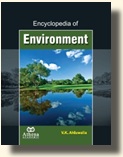
|
Encyclopedia of Environment - V.K. Ahluwalia |
|
|
Cover Price : Rs 2,495.00
|
Imprint : Ane Books Pvt. Ltd.
ISBN : 9789386761989
YOP : 2016
|
Binding : Hardbound
Size : 8.5" X 11.00"
Total Pages : 400
CD : No
|
|
About the Book
The main thrust of this Encyclopedia is on the understanding of environmental processes and pollution. It includes pollution of all environmental segments (atmosphere, hydrosphere and lithosphere) and the effects of various pollutants on human health. In addition to marine pollution, noise pollution, radioactive pollution, vehicular pollution, industrial pollution, thermal pollution, the effects of various pollutants on human health are included. Other topics covered are toxicology, toxic metals environmental carcinogens, natural resources, ecosystems, biodiversity, urbanization, ecological succession, wetlands, global warming, greenhouse effect, ozone hole, acid rain, environmental degradation, environmental episodes, nuclear episodes, natural disasters, environmental movements, environment and energy, environmental biotechnology, organic farming, biofertilizers, biopesticides, environmental laws, international agreements and green chemistry, which is useful for checking industrial pollution. Twelve appendices dealing with various standards are also given..
About the Author
V.K. Ahluwalia has worked as professor of chemistry, University of Delhi, Delhi for more than three decades and taught postgraduate and M.Phil students. He has guided about 80 students for M.Phil/Ph.D degrees and has published more than 250 research papers in National and International Journals. He has delivered a number of invited lectures in India and Abroad. Prof. Ahluwalia worked as post-doctoral fellow for two years (1960-1962) and worked with Prof. Harold Shechter at the Department of Chemistry Ohio State University, Ohio USA and for one year (1980-81) with Professor Herbert C. Brown, Nobel Laureate at the Department of Chemistry, Purdue University, USA. He has also been a visiting professor at Dr. B.R. Ambedkar Centre for Biomedical Research University of Delhi, Delhi. Prof. Ahluwalia has authored many books a few of which are, Reaction Mechanism, Environmental Chemistry, Environmental Science, Environment Education, Environmental Pollution and Health and Organic Synthesis. His Book on Green Chemistry is the winner 2009 Choice award, being the outstanding academic title. |
|
 |
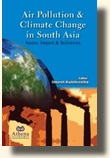
|
Air Pollution and Climate Change in South Asia : Issues, Impact and Initiatives |
|
|
Cover Price : £ 39.99
|
Imprint : Athena Academic
ISBN : 9781910390344
YOP : 2017
|
Binding : Hardbound
Size : 6.25" X 9.50"
Total Pages : 406
CD : No
|
|
About the book
The issues of air pollution and climate change have been the highlights of global media because of public concern. Scientific findings have established that the present climate change is a reality and not a hype any more. This book addresses the problem of air pollution responsible for climate change with a critical analysis of various aspects as given in different chapters. The book describes the sources of air pollution, drivers of climate change, impact of air pollution, regional resilience, deposition of air pollutants to various ecosystems, demographic shift and mitigation options for air pollution and climate change. It specifically highlights the global warming consequences in Indian region. All the chapters of this book have been written by the young and budding researchers.
Contents
Introduction
Air Pollution Sources
Air Pollution in Megacities
Air Pollution from Fireworks and its Impact on Air Quality and Health
Indoor Air Pollution During Traditional Cooking and its Socio-Economic Impacts on Rural Population in North India
Atmospheric Deposition and Ecosystem Sensitivity
Estimation of Emission from Crop Residue Burning; Study Over North-West India During Harvesting Season
Impact of Air Pollution on Plants
Drivers of Climate Change
Regional Climate Resilience
Climate Change and Demographic Shift
Human Induced Calamities
Climate Change Mitigation
Climate Change: Managing Impacts Through Policies
Summary
About the Editor
Dr Umesh Chandra Kulshrestha is a Professor at the School of Environmental Sciences, Jawaharlal Nehru University, New Delhi. He is also the Director, Tran- disciplinary Research Cluster at JNU, and Deputy Director, South Asian Nitrogen Center, New Delhi. His research interests include Chemistry and Climate Change, Air Pollution Monitoring, Atmospheric dust and depositions, Transport and Chemical Transformations, Chemistry of Rain and Snow, Reactive Nitrogen, Air Pollution Biomonitoring etc. He has been associated with various international and national programs on atmospheric sciences including INDOEX, ABC, IGAC-DEBITS-CAD, CAAP, Surya and ICARB etc. Prof Kulshrestha is a recipient of a number of awards viz. START Young Scientist Award by IGBP-START, USA, Thomas Kuhn Honor Pin by IUAPPA and International Academy of Sciences, CSIR Young Scientist Award, and M S Krishnan Gold Medal by Indian Geophysical Union (IGU). He has been a reviewer of IPCC AR5 and Review Editor of WMO/UNEP Integrated Assessment Report on Black Carbon and Ozone 2011. He has been a Guest Editor for Advances in Meteorology. He has been associated as Editorial Board member with the J Indian Geophysical Union, IORE J Environmental Science, Energy Environment and Carbon Credits, Indian J Chemistry-A. He is a Review Editor for Frontiers in air pollution. Prof. Kulshrestha is a Fellow of Indian Geophysical Union. He has co-authored three books |
|
 |
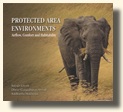
|
Protected Area Environments – Airflow, Comfort and Habitability |
Author |
Satyjit Ghosh
Dhruv G Arvind
Siddhartha Mukherjee
|
|
Cover Price : Rs 1,495.00
|
Imprint : Ane Books Pvt. Ltd.
ISBN : 9789389212754
YOP : 2019
|
Binding : Hardbound
Size : 9.50" X 8.50"
Total Pages : 152
CD : No
|
|
About the Book
The iconic Masai Mara National Reserve in Kenya and the Mudumalai Tiger Reserve in South India have been revisited by the authors in this book. This book’s discourse delineates step-by-step, the process of quantifying comfort levels of lions and tigers within these protected areas. It is seen that the Predicted Mean Vote values -measures of thermal comfort- exceed comfortable ranges. This calls for a detailed exploration on sustainable development in protected areas. Four diverse chapters illustrate how modern tools in Computational Fluid Dynamics are used along with standard ecological methods to ascertain the extent of airflow, levels of hydration and land-use pattern changes affecting the prevailing micro-climate.
The intimate relationship between man and animal and its portrayal in Tamil and Masai literature and other art forms have been discussed and placed in context with stunning photo-graphical renditions of topography, flora and fauna. This adds a new dimension to the book – protected areas call for dialogues at many levels -technical, social and above all, aesthetic. The book, with its lush coffee-table appeal, should be compulsive reading for all animal lovers, environmental scientists and landscape architects worldwide.
Contents
CHAPTER 1: Ventilation and Aeration in Game Reserves
1 The Microclimate
1.1.1 Natural Landscaping of Game Reserves
1.1.2 Boundary Layer Characteristics
1.2 Meteorological Analysis of Mudumalai and Masai Mara
1.3 Anthropogenic Imprint – Development, Industrial activity and Tourism Impact on Air Quality
1.4 Sensitivity and Comfort levels of Tigers in Mudumalai
1.4.1 Analysis of Extant Microclimates Using Computational Fluid Dynamics
1.4.2 Mathematical Interpretation of Thermal Comfort
1.4.3 Calculation of PMV for the Tigers in Masinagudi
CHAPTER 2: Despair, Hope and Glory – The Mudumalai Story
2.1 Mudumalai as a Hotspot of Biodiversity
2.2 Terrain, Vegetation and Hydration
2.3 Human Dimensions of Wildlife – Conflict and Resolution
2.3.1 Conflict
2.3.2 Redeeming Features of Mudumalai
2.4 Conservation
CHAPTER 3: Masai Mara – Nature’s Own Sculpture Park
3.1 Kenya, Africa and the World
3.2 Approaching the Savannah
3.3 High-end Tourism
3.4 Airflow and Hydration
3.5 Sustainable Practices in the Masai Mara
CHAPTER 4: Humanity’s Dialogue with Animals
4.1 Literature
4.2 Beliefs and Customs
Epilogue
References
About the Authors
Dr. Satyajit Ghosh is currently Senior Professor at the School of Mechanical Engineering, VIT University, Vellore, India. He is also Associate Member of the School of Earth and Environment, University of Leeds, United Kingdom. Previously, he has worked on fluid flows in environmental systems at the University of Cambridge, United Kingdom. He also teaches and researches on the generic themes of energy efficiency in the built environment. His papers have been published by the Royal Society of Great Britain and other leading journals from all across the world. CNN International, the BBC and Indian media have also covered his research. His research group in VIT has worked on numerous innovative applications such as the development of rain simulators for rain-starved regions of India and adjustable agricultural sprays to minimize spray drift. He was given the prestigious Atmospheric Science Letters Editor’s Award by the Royal Meteorological Society in 2012. He and his students also developed a unique cyclone alerting system – this was picked by the international media. Dr. Ghosh was on the Plenary Session of an international conference organised by the SAARC Cultural Centre, Colombo, Sri Lanka in 2014, where he presented an architectural rendering of the ancient Ratnagiri Monastery in Odisha, India.
Dhruv’s interest in nature and wildlife started at a young age, through exposure to wildlife in National Parks and Tiger Reserves across India. In addition, he has gained insight into projects at the Madras Crocodile Bank Trust in Tamil Nadu and at the Agumbe Reptile Research Station in Karnataka, under the guidance of renowned conservationist Gerry Martin. During his UG study in VIT he was guided by Prof. Satyajit Ghosh. His research has always been interdisciplinary, incorporating foundational principles in ecology through mathematical interpretations. He graduated from the School of Geography and the Environment at the University of Oxford, UK, where he worked on governmental and policy-based issues pertaining to India’s cattle-complex, human-wildlife conflict and urban ecologies as a geographer.
Siddhartha Mukherjee is currently a PhD student at the Department of Chemical Engineering in Delft University of Technology, the Netherlands, where he works on transport phenomena and computational fluid dynamics. An alumnus of VIT University, Vellore, he traces back the roots of his research interest in fluid mechanics to during his Bachelors education in Mechanical Engineering. Also an avid photographer with a passion for art, his first serious step in the direction of academic research was with a synthetic project combining architectural aesthetics in the Indus valley civilization with mechanical engineering, where he studied the energy efficiency of these ancient building forms in light of modern-day engineering driven sustainable building design, under the guidance of Prof. Satyajit Ghosh. This research helped him secure a fully funded admission to TU Delft for a Masters in Mechanical Engineering. His outlook is to strike a harmony between science and art, for the two he believes are equally important and relevant to life and society. He also enjoys Classical music and plays the guitar and piano.
Both, Siddhartha and Dhruv have been mentored by Prof. Satyajit Ghosh. This book has been compiled as part of Dhruv’s final year project work at VIT University, Vellore. |
|
 |
|